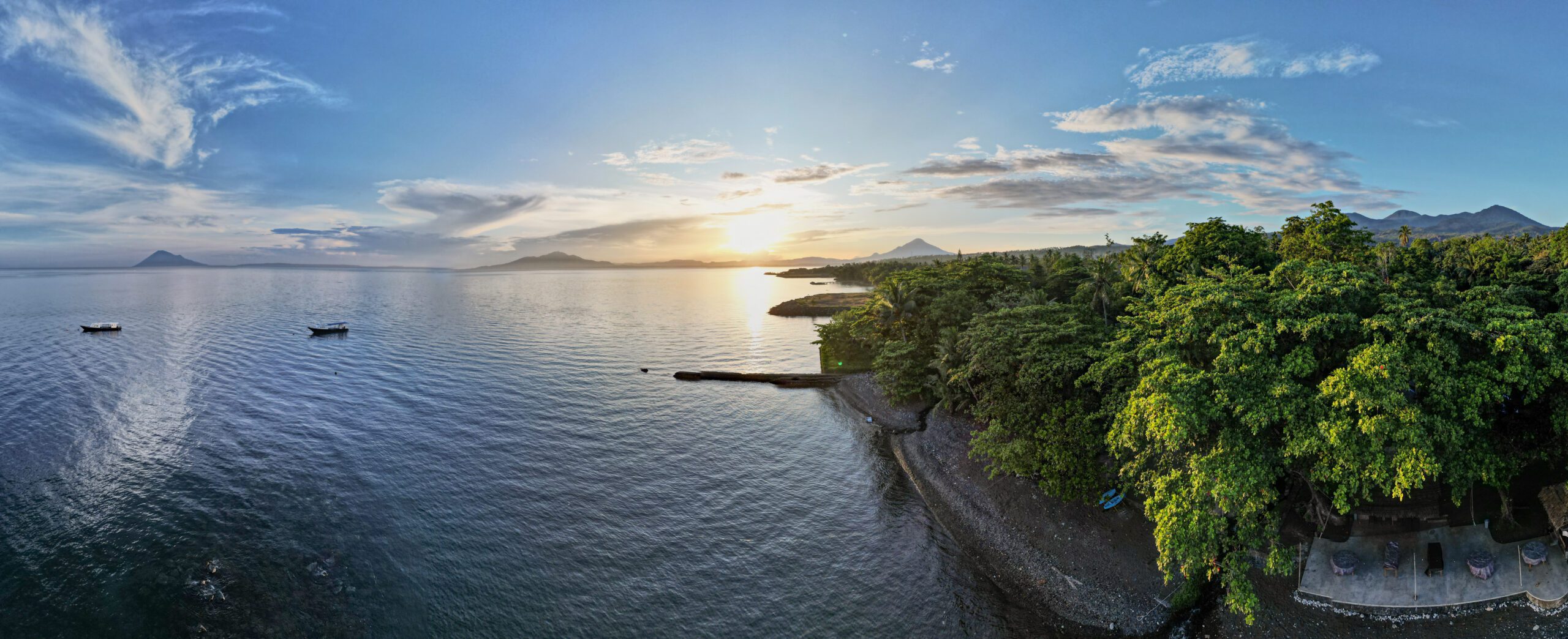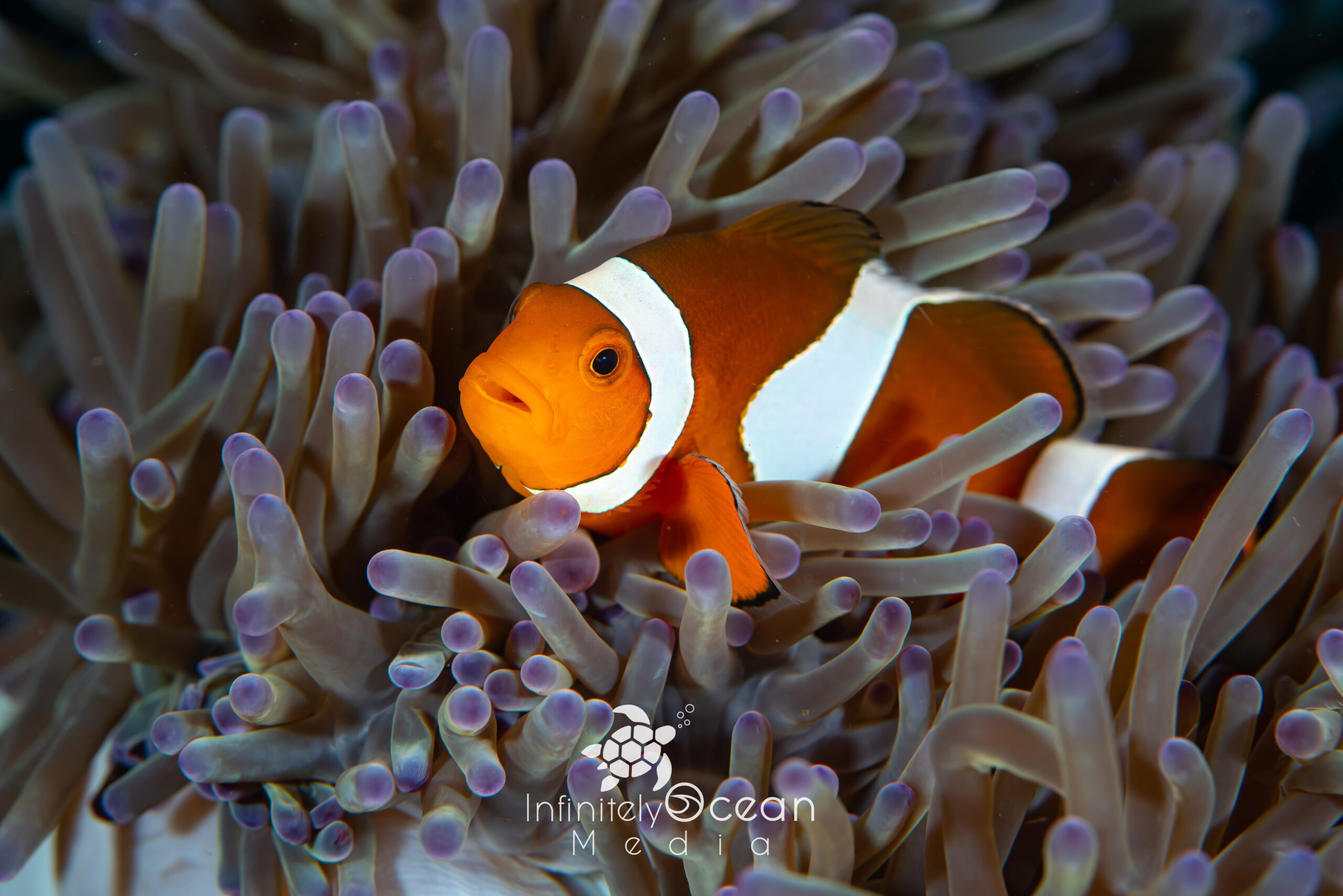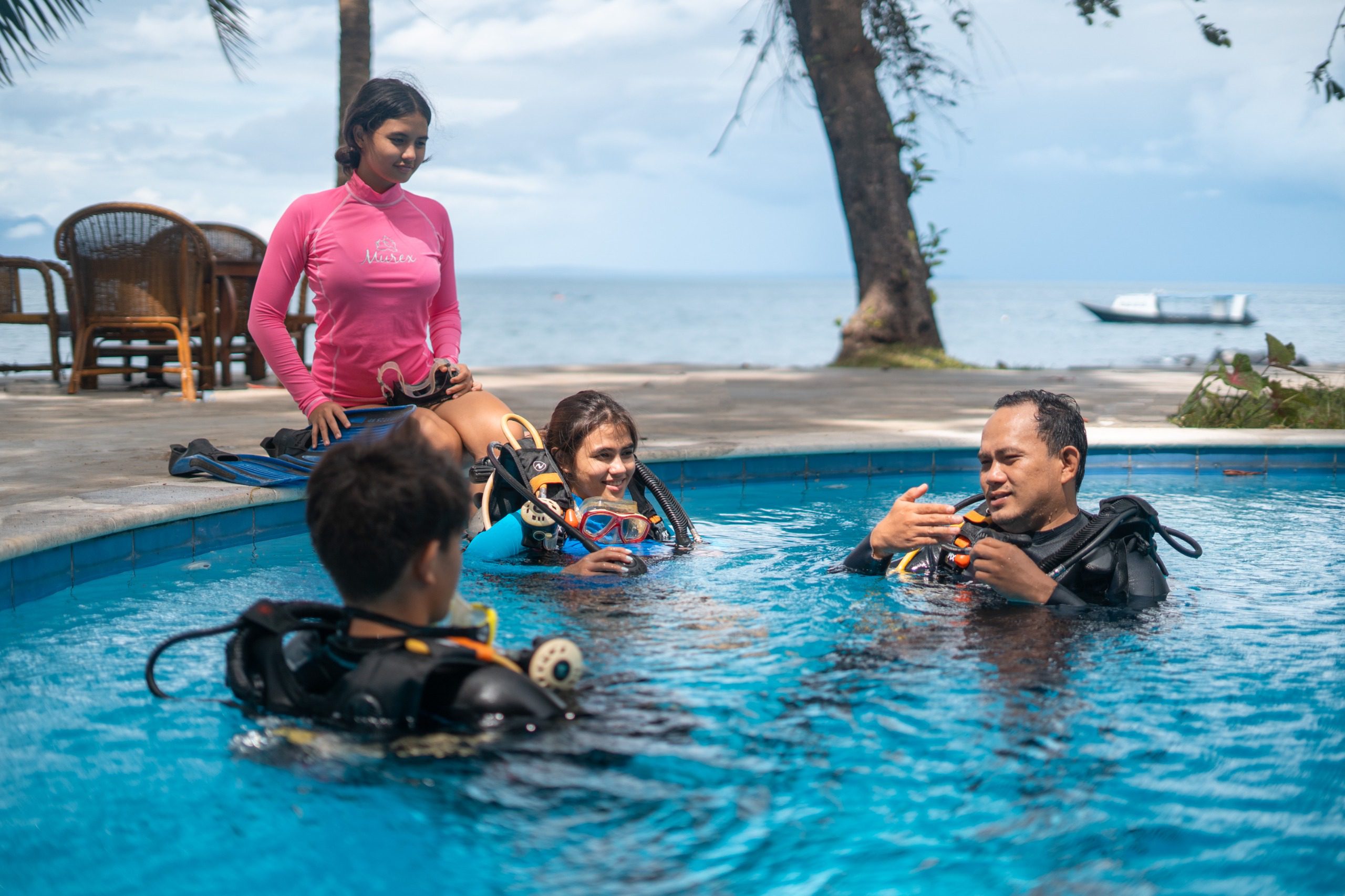
Murex Manado Resort House Reef Diving
At Murex Manado, our house reef is incredibly diverse, extremely productive, and literally just steps away from the resort itself! When staying with us, scuba divers, freedivers, and snorkelers have the luxury of choosing between boat trips or simply taking it easy and exploring the nearby reefs at their own pace.
For your first dive on our house reefs in Bangka and Manado, one of our guides will be happy to show you around. For all subsequent dives in these locations, you can explore independently and for FREE!
Whether you’re into macro critters, reef fish, or cryptic crustaceans and cephalopods, our house reef rarely disappoints. In this article, we look at the reef in more detail, from its topography to the organisms that make their home here, and the many opportunities the reef presents to anyone staying at Murex Manado.

The house reef is just steps away from the resort
Located Literally Steps Away…
Location is key when discussing house reefs and the Murex Manado Resort House Reef couldn’t be positioned any better. The entry to the house reef is from the black sand beach directly in front of the resort’s oceanfront restaurant and outdoor dining area. For those staying at Murex’s Manado resort, the convenience of the house reef is a rare treat, often unrivaled elsewhere.
The equipment and gear lockers, wash tanks, and kit up areas are positioned immediately behind the beach. This setting allows divers, freedivers, and snorkelers to prepare and return from the reef in a compact area without having to carry gear or move from one place to another.
Once ready to dive, freedive, or snorkel, the water’s edge is only a matter of steps away.
House Reef Entries & Exits
Entry to the Murex Manado House Reef is by making a shore entry from the black sand beach in front of the resort. There is a short walk (30 seconds) across the sand to the shore and it’s an easy wade out to water deep enough to don fins without damaging any corals. Once ready to descend into the shallows (less than 5meters/15feet) swim out, following the sandy channels away from the shore, towards the main boat buoy. You should begin to see the first of the underwater markers (floats on ropes) and your dive starts here!
Note on Exits: To avoid damaging coral life when exiting the house reef you should aim to return to this entry point. Make a shore diving exit by removing your fins and walking back to the beach via the sandy channels.
Manado House Reef Dive Site Overview & Navigation
Murex Manado House Reef is a very gently sloping reef that plateaus and is almost flat in places. The reef top is very wide and runs from a couple of meters/6 feet, to around 12 meters/39 feet, before it eventually slopes more steeply. This large reef flat is a definite positive – it’s packed with critters!
Topographically, the Murex Manado House Reef can be broken down into 3 different sections, as follows:
Shallow Coral Reef Top: 2-6 meters/6-18 feet
Upwards of 6 meters (18 feet), and closest to the shore, there is a mixed/combination slope down to a wide sandy plateau. This section of the reef, which runs parallel to the shore, offers sandy patches, branching corals, bommies, and patches of hydroids and anemones. It’s an area that’s well worth exploring for critters. We recommend spending more time in this area on the return from your dive as it is also the ideal depth for your safety stop!
Among the coral patches and vibrant anemones you’ll find anemonefish, moray eels, nudibranch, scorpionfish, and an array of smaller reef fish including damsel fish, parrotfish, butterflyfish, cardinalfish, and Moorish idols passing through. The sandy patches are also home to several species of blind shrimps that live in symbiosis with gobies. Look out for these shrimps tirelessly digging their tunnels while the goby stands guard!
Coral and Sandy Plateau: 6–12 meters/20-39 feet
Once you have made the initial swim down to around 6 meters you will see the wide sandy plateau in front of you.
The plateau offers more sandy patches, coral outcroppings, and an array of different artificial reef items including fishballs and other manmade structures. The structures have been carefully placed with a view to providing habitat for marine life and growing surfaces for corals.
It’s possible to navigate this area by swimming a zigzag pattern along it – this is where most divers spend the majority of their time – critter hunting!
If you prefer to take a circular route, bare left, keeping the shore to your left shoulder, and swim a full loop, taking in the slope at the deepest and furthest point (left shoulder to the open ocean), before closing the loop from the right side of where you started.
Common marine life species spotted here include an array of possible nudibranch, mantis shrimps (peacock sp.), reef octopus, broadclub cuttlefish, banded sea kraits, ribbon eels, tasseled scorpionfish, look out for stingrays on the sand, and take your time inspecting the bommies for camouflaged critters that have taken up residence! There is no shortage of things to see on this packed sandy plateau – especially when accompanied by a Murex Resort’s Dive Guide to assist with spotting. The only limitation will be your bottom time!
Sandy Slope: Starting from Approx. 12 meters/39 feet
Swimming directly out from the shore (perpendicular to the beach), once you have crossed the sandy plateau, the sand eventually drops away into a much steeper slope. At first glance, this sandy slope may appear barren but it is interspersed by small hard corals, anemones, and hydroids that grow on any available surfaces. However, one of the highlights of the slope is looking out to the blue ocean. It’s not uncommon to see schools of silvery fish streaming by, passing rays, or even hunting predators.
It’s worth noting that in this area, dolphin and pilot whale pods, have been frequently spotted on the surface – and they have even been seen from the resort!
Marine Life Highlights on Murex Manado Resort House Reef
The Murex Manado Resort house reef is in the wider Manado Bay area and as such, divers can expect to see some impressive marine species. As with any reef, there are almost ‘guaranteed-to-see species’ that appear to have taken up residence, but there is also an abundance of some of Indonesia’s most unusual and rarest marine species that are frequently passing through. One of the highlights of diving here is learning to expect the unexpected!
Below is a small selection of some of the most common, and some of the more unusual, species that we see when diving on the Murex Manado Resort House Reef…
Cephalopods:
Let’s remember that the Murex Manado Resort House Reef forms part of Manado Bay… in North Sulawesi..! This is a critter-packed house reef and a wide variety of cephalopods can be spotted here.
During the day, look out for reef octopus, big fin reef squid (check the mooring buoy and line), broadclub cuttlefish, and pygmy cuttlefish. Night dives however are when the house reef is most alive with cephalopods. During night dives, additional sightings of long-arm and starry night octopus, and bobtail squid are not unusual. It’s possible to encounter other species from time to time including blue ring and coconut octopus too.

Coral shrimps are just one of the crustaceans found on the Murex Manado Resort House Reef
Crustaceans:
Crustaceans are certainly not in short supply on the Murex Manado Resort House Reef. A hoard of shell-bearing critters have made this stretch of reef their home and are frequently spotted displaying an array of behavioral displays from egg-carrying to shell-shedding.
- Around the artificial reef structures on the sandy plateau look out for peacock and pink earred mantis shrimps.
- Anemones attract anemone shrimps, sexy shrimps, and porcelain crabs.
- Cleaner shrimp attract a range of ‘customers’ in need of cleaning, including moray eels and medium sized reef fish.
- Check any whip corals for well-disguised whip coral shrimp (image above)
- Other crustaceans of note include Donald Duck shrimps, orangutan crabs, emperor shrimps, and harlequin crabs – but the possibilities are endless!
 Night diving: Crustaceans are often best seen at night and night dives on the Murex Manado House Reef reveal an abundance of nocturnal critters including decorator and sponge crabs.
Night diving: Crustaceans are often best seen at night and night dives on the Murex Manado House Reef reveal an abundance of nocturnal critters including decorator and sponge crabs.

The Shaun the Sheep nudibranch is often spotted in Manado Bay
Nudibranch:
The spectrum of nudibranch species spotted on the Murex Manado Resort House Reef is extraordinary. Species come and go throughout the year and seemingly with the seasons. That being said, on any given day it’s possible to spot flabellina, chromodoris, aeolid, nembrotha, doridae, pleurobranch, and hexabranch, including the Spanish Dancer (Hexabranchus sanguineus).
Some of the nudibranch species spotted on the house reef over the years have yet to be recognized and classified scientifically!
Schooling Fish:
Schooling fish is a frequent sighting on the house reef. Look out for shade-dwelling batfish (spadefish) underneath, or close to, the moorings and boats. Schools of reef squid can also be spotted here while basking just beneath the surface.
Over the branching corals, schools of damsels can be seen swarming in unison, whereas from the sandy slope, looking out to the open ocean, schools of fusiliers and mackerel can be seen streaming through the blue.
Reef Fish:
The ‘Indo-Pacific’ has the world’s most abundant of all waters. There are nearly 4,000 species of reef fish (including coastal fish species) living on coral reefs within this zone – of which the Murex Manado Resort House Reef is part!
The house reef showcases some of Indonesia’s most colorful, intriguing, and striking reef fish. It is impossible to list every single species that we see here, but here are some of the most common groupings of reef fish that are spotted on the Murex Manado Resort House Reef:
Filefish, trunkfish, boxfish, pufferfish, and triggerfish, scorpionfishes, surgeon and unicornfish, groupers and rock cods, parrotfish, angelfish, butterflyfish, damsels and serjeants, snappers, wrasses, flounders, frogfish, cardinalfish, gobies, batfish, and sweetlips. The list is exhaustive and reef fish are just one group of marine species found here!

Cowfish are common sightings on the Murex Manado House Reef
Pelagics /Predators:
While large predatory species are not as prevalent on the Murex Manado Resort House Reef as they are on the Murex Bangka House Reef, sightings of passing reef sharks and tuna are not unusual from the sandy slope when looking out to the open water. For scuba divers, freedivers, and snorkelers who want to see larger predators and sea turtles, a day trip to the Bunaken Marine Park is highly recommended.
Rays:
The sandy patches and plateau on this reef are ideal for spotting stingrays that hide beneath the sand – often with only their eyes on display! Spotted eagle rays are occasionally seen from the deeper sandy slope.
Night Diving:
It would be remiss not to mention night diving when discussing the Murex Manado Resort House Reef! When the sun begins to set, this dive site starts hotting up with many nocturnal species coming out from their daylight hiding places.
Needless to say, night diving on the house reef is highly recommended – particularly for those wishing to see the nocturnal cephalopod, invertebrate, and crustacean species for which North Sulawesi is best known.

Reef squid image while night diving in Manado Bay
Murex Manado House Reef Diving Tips
Here are a few tips for those planning to scuba dive, freedive or snorkel on the Murex Manado Resort House Reef. If you have any questions that have not been addressed or answered here, contact us for more information – our reservations team looks forward to assisting you!
Take a Murex Dive Guide with you:
We hope all guests staying at Murex Manado Resort with unlimited house reef scuba diving, freediving, or snorkeling included in their packages enjoy exploring the house reef. However, we recommend that guests make their initial house reef dives with a Murex Resorts Dive Guide. Dive Guides are not only great spotters, they will also assist and give you advice on entries and exits, navigating the reef, and other tips that will enhance your future dives.
Tell Murex Resorts staff you are diving and what time:
If you are diving the house reef with a buddy, let Murex Resorts’ staff know what time you are diving and for how long. This not only increases safety but our dive center team will also prepare your gear and tanks in advance.
Time your dives:
When diving the Murex Manado Resort House Reef, it is best dived around the time of mid to high tide. The best time for diving varies daily according to the tides, weather, and sea conditions.
Check with our team of Dive Guides and they will be able to advise you according to conditions on any given day – and prepare your gear for you in advance!
Good diving practice:
Observe general good diving practices during your dives. Good diving practices include:
- Maintain neutral buoyancy and minimize contact with the reef
- Look but don’t touch
- Do not harass, chase, or stress marine life
- Maintain constant buddy contact
- Check your tank pressure frequently
- Dive within your limits (and any limits of your diving certification)
- Plan your dive and dive your plan
- Practice a 3minute safety stop at 5meters at the end of every dive. There is still plenty to see at 5meters on the Murex Manado Resort House Reef!

Freediving in North Sulawesi with Murex Resorts
Freediving in Manado Bay, Bunaken, and North Sulawesi
Did you know that the Murex Manado Resort House Reef also offers excellent opportunities for freedivers? If scuba diving is not for you – or if you are a diver and want to try something new, we offer the full range of AIDA free diving courses! For certified freedivers, the house reef is a beautiful site for all levels.
Join Us For A Passport To Paradise
If you are trying to decide where to stay in North Sulawesi then why not join us for a Passport to Paradise? Instead of limiting yourself to one destination, explore all three of our distinct diving destinations in one easy trip: Bunaken, Bangka , and Lembeh.
Our resorts are connected by boat diving transfers. There is no wasted travel time and even more time underwater as you simply dive your way from resort to resort!
Not only does Murex Manado Resort offer a stunning resort house reef, Murex Bangka Resort, and Lembeh Resort have incredible house reefs too!
Get In Touch!
Contact us at reservations@murexresorts.com. You may also want to check out Murex Resorts’ rates and reserve your spot now.
We look forward to welcoming you to North Sulawesi!
FURTHER READING:
If you enjoyed reading this, you may also be interested in some of our other recent articles:








